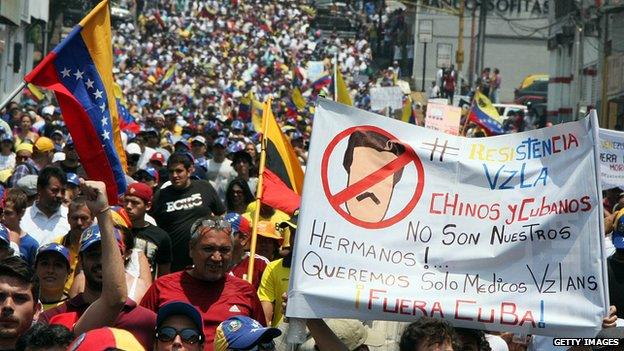San Cristobal: The birthplace of Venezuela's protests
- Published

Clashes broke out in San Cristobal following a march over the alleged attempted rape of a student
Rocks, logs, rubble, discarded furniture, assorted rubbish and even an old armoured car: anything that can be used is being used to shut down the streets of San Cristobal, the Venezuelan city that gave birth to the current wave of protests against President Nicolas Maduro.
Here they have been at it for more than a month, after students of a local university took to the streets and clashed with the authorities, following the alleged attempted rape of one of their classmates.
And now large parts of the capital of the north-western state of Tachira look as if they are under siege, with barricades blocking avenues and the entrances to shopping districts, neighbourhoods and residential complexes.
"There are more than 100 barricades," the city's mayor, Daniel Ceballos, told the BBC.
"About 40% of San Cristobal is affected," he added.
The situation, however, feels much worse. Most of the city comes to an almost complete standstill every day after 15:00.
And, so far, every time the state governor, Jose Vielma Mora, has asked for a return to normalcy, the answer has been more barricades.
List of grievances
It is not surprising that every aspect of daily life has been badly affected.
Every morning, huge queues form in front of the few shops that are open, as people queue for hours to buy bread, milk or flour.
But San Cristobal is an opposition stronghold, and difficulties in buying basic goods have been part of daily life since long before the recent protests.
There are more than 100 barricades in the city as Arturo Wallace reports.
Insecurity and food shortages are only two items on a long list of grievances that seems to have united a significant part of the local population against Mr Maduro's government.
"This fight is no longer students-only. It's also a fight because even in normal times you cannot get milk or bread," said opposition activist Vianey Carvajal.
"I don't mind [the blockades]. I'd rather suffer them for another month than suffer this government for four more years," said America Ruiz, as she crossed a barricade to look for soap in one of the more badly affected neighbourhoods.
Among the San Cristobal protesters, nobody denies that the ultimate objective now is to force deep changes in the government, maybe even topple it.
But nobody seems to know how to achieve it, other than by "resisting".
'Creating chaos'
"We have to be patient. This won't be a struggle of days. The Venezuelan who believes we will get rid of Maduro with these protests is delusional," said Pedro Pablo Quitero, a 60-year old university teacher who sympathises with the protesters.
But others are saying the "gochos", as the inhabitants of this Andean region are called, should march into Venezuela's capital, Caracas, to set up a new government like they did in 1899.
Meanwhile, the government still disputes the idea that the majority of the inhabitants of San Cristobal support the protests.

Thousands of opposition activists marched in San Cristobal on the anniversary of Hugo Chavez's death
And Jonathan Garcia, a local MP with the ruling United Socialist Party, told the BBC it was all part of a right-wing conspiracy aimed at creating chaos and violence to justify a foreign intervention.
"But we won't give them the excuse they're looking for by removing the protesters by force, like you would do in any other country in the world," said Mr Garcia.
"We know they have the cameras, the videos to try to convince the world that the unarmed people of Venezuela are being violently repressed by a tyrannical government in order to justify an US intervention," he added.
Armed groups
That might explain why, despite all the discontent, San Cristobal remains pretty calm during the day - and there have not been reports of large violent clashes lately.
However, after nightfall the situation changes.
The protesters have accused the government of employing armed groups of civilians that routinely harass or attack them under the cover of night, and they insist that is why they need the barricades.
But the authorities imply that the clashes are a result of disgruntled neighbours trying to set themselves free of the restrictions imposed by unwelcomed protesters.
It is difficult to tell how long the situation will go on, but there's one slogan common to almost all the barricades: "He who tires, loses."
The government has called for dialogue. And all of Venezuela's opposition will also be looking at what happens in San Cristobal very carefully.